


 النبات
النبات
 الحيوان
الحيوان
 الأحياء المجهرية
الأحياء المجهرية
 علم الأمراض
علم الأمراض
 التقانة الإحيائية
التقانة الإحيائية
 التقنية الحيوية المكروبية
التقنية الحيوية المكروبية
 التقنية الحياتية النانوية
التقنية الحياتية النانوية
 علم الأجنة
علم الأجنة
 الأحياء الجزيئي
الأحياء الجزيئي
 علم وظائف الأعضاء
علم وظائف الأعضاء
 الغدد
الغدد
 المضادات الحيوية
المضادات الحيوية|
Read More
Date: 4-11-2015
Date: 4-11-2015
Date: 4-11-2015
|
Phylum Chordata
This phylum derives its name from one of the common characteristics of this group namely the notochord (Gr. noton, back + L. chorda, cord). The animals belonging to all other phyla of the Animal Kingdom are often termed ‘the non -chordates’ or ‘the invertebrates’ since they have neither notochord nor backbone in their body.
The backboned animals (vertebrates), together with a few closely related animals which do not possess a backbone, are included in this phylum. Most of the living chordates are familiar vertebrate animals. The chordates are of primary interest because human beings are members of this group.
Diversity of Chordates
The chordates exhibit an astonishing diversity in form, physiology and habits. The number of chordate species is limited. About 49,000 species are on records which are only half of the living species of molluscs and less than one tenth of arthropods. Despite their modest number of species, the chordates make remarkable contribution to the bio-mass of the earth. Nearly all of them are medium to large in size. The vertebrates in particular are considerably larger and many of them are among the largest of living animals. The gigantic blue whale which is 35 meters long and 120 tons in weight is the biggest known animal. The smallest vertebrate, philippine goby is a fish, measuring only 10 mm in length. The chordates are able to occupy various kinds of habitats. They have adapted themselves to more modes of existence than any other group. They are found in the sea, in freshwater, in the air and on all parts of land from the poles to the equator.
General Characters:
The three distinctive characteristics of the chordates are the presence of notochord, dorsal tubular nerve cord and pharyngeal gill slits.
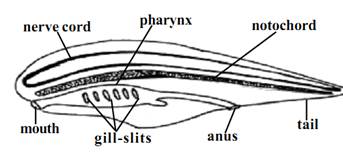
Fig. 1.2.17 Chordata - a diagrammatic structure
1-Notochord:
During the embryonic development of a chordate there appears a supporting rod called the notochord. It lies dorsal to the alimentary canal and ventral to the nerve cord. In some chordates this structure persists throughout life. In others it is partially or completely replaced by a ‘backbone’. It is made up of separate bony elements or vertebrae. Structurally it is composed of large number of specialized vacuolated cells. It is surrounded by fibrous and elastic sheath. The stiffness of the notochord is due to the turgidity of fluid-filled cells and surrounding connective tissue sheath.
2-Dorsal tubular nerve cord
The nerve cord lies just above the notochord and remains entirely outside the coelom. It is a tubular structure having a small hollow canal running from one end to the other. The dorsal hollow nerve cord persist throughout the adult life of almost all chordates.
3-Gill slits or Pharyngeal clefts
These are paired lateral clefts leading from the pharynx to the exte-rior. They are present throughout life in fishes and a few tailed amphibians. In amphibians, like frogs and toads it is found only in the larval stages. In higher vertebrates (reptiles, birds and mammals) they are embryonic and non-functional.
4-Ventral heart
The heart is chambered. It is located ventral to the alimentary canal
5-Closed blood vascular system
In chordates, the blood passes through a continuous system of tubes namely arteries, capillaries and veins.
6-Hepatic portal system
In chordates, the food laden blood from the digestive tract passes through the capillary net work in the liver, before reaching the heart. Thus the veins originating from the digestive tract as capillaries and ending in the liver again as capillaries constitute the hepatic portal system.
Classification
The Phylum Chordata is classified into four sub phyla:
Sub phylum 1. Hemichordata
Sub phylum 2. Cephalochordata
Sub phylum 3. Urochordata
Sub phylum 4. Vertebrata
First three sub phyla are collectively known as Protochordates. Since the members of these sub phyla do not have a cranium or skull they are also referred to as Acrania.
Protochordata (Acrania)
The protochoradates are considered as the fore runners of vertebrata The classification of the protochordates is based on the nature of the notochord.
Sub phylum: Hemichordata.
These are exclusively marine organisms. They are solitary or colonial forms. They mostly remain as tubiculous forms. The body is soft, vermiform, unsegmented, bilaterally symmetrical and triploblastic. The body is divisible into three distinct regions namely proboscis, collar and trunk. The body wall is composed of single layer of epidermal cells. The dermis is absent. They have no endoskeleton. A projection from pharynx, projecting inside the proboscis may be considered as notochord. They have a spacious coelom lined by coelomic epithelium. The alimentary canal is a straight tube running between mouth and anus. They are ciliary feeders. Sexes are separate.
Examples: Balanoglossus, Saccoglossus.

Sub phylum: Cephalochordata.
Cephalochordates are small fish like marine chordates. The persistent notochord extends forward beyond the brain. Hence these are called cephalochordates. The epidermis is single layered. Paired fins are absent. Muscles, nephridia and gonads are segmentally arranged. The pharynx is large with numerous gills. It is a filter feeder.
Example: Amphioxus.

Sub phylum: Urochordata
This taxon constitutes a unique group of animals exhibiting diversity in form and habit. In Urochordata the notochord is confined to the tail region of the larva. The adults are mostly degenerate, sessile forms. The body is enveloped by a tunic or test. The free end of the body bears two openings, the mouth and the atriopore. The proximal part of the alimentary canal is greatly enlarged to form a spacious pharynx. They are hermaphroditic animals. The development occurs through free swimming tadpole like larva.
Example: Ascidia, Doliolum, Salpa.
Sub phylum: Vertebrata (Craniata)
This group is characterized by the presence of brain case or cranium and a vertebral column which forms the chief skeletal axis of the body.
The notochord is an embryonic structure. It is replaced in the adult stage by a cartilaginous or bony vertebral column. The body is covered with an integument having an outer epidermis and an inner dermis. The skin has many modifications such as glands, scales, feathers, claws horns and hairs.
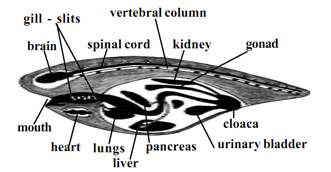
Fig. 1.2.21 A vertebrate- diagrammatic structure
The digestive system is ventral to the vertebral column. It is provided with a large liver and pancreas. The circulatory system consists of the ventral, chamberd heart. The circulatory system is of a closed type with arteries, veins and capillaries. The blood plasma contains red and white blood corpuscles. Gill slits are limited in number (usually 5 pairs). There are two pairs of appendages. The anterior part of the nerve cord becomes differentiated into brain and spinal cord. The special organs of sense like the nose, eyes and ears are closely connected with the brain. Urinary and genital systems are closely connected to form a urinogenital system
The sub phylum vertebrata may be classified into two groups
i)Pisces and (ii). Tetrapoda)
Class: Pisces
Fishes are poikilothermic, aquatic vertebrates with jaws. The body is streamlined. It is differentiated into head, trunk and tail. Between head and trunk, the neck is absent. Locomotion is affected by paired and median fins.

The body has a covering of scales. They are of various types like placoid, cycloid, ctenoid and ganoid scales. The body muscles are arranged into segments called myotomes.
The Alimentary canal consists of a definite stomach and pancreas and terminates into cloaca or anus. Respiration is performed by gills. Gill slits are 5-7 pairs. They may be naked or covered by an operculum. The heart is two chambered (an auricle and a ventricle).
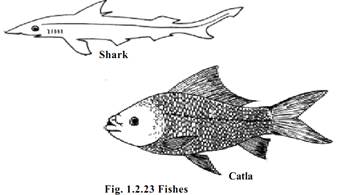
Sinus venosus and renal portal system are present. The red blood corpuscles are nucleated. The functional kidney of the adult is of mesonephric type. The external nostrils do not communicate with the buccal cavity. Lateral line sense organs are well developed. Sexes are separate. Fertilization is either internal or external. Examples: Shark, Catla.
Tetrapoda
The vertebrates with two pairs of limbs adapted for locomotion on land are known as tetrapods. The limbs are of pentadactyl type. The tetra- pods are identified by a cornified outer layer of skin and nasal passages communicating with mouth cavity and lungs. The super class Tetrapoda is divided into four classes namely. Amphibia, Reptilia, Aves and Mammalia.
Class: Amphibia
The living representatives of this class include frogs, toads, newts, salamanders and limbless caecilians.
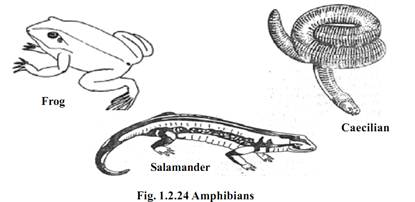
The transition from aquatic to terrestrial living is clearly indicated in the class Amphibia. These were the first vertebrates to live on land. Amphibians are not completely land adapted. They hover between aquatic and land environments. This double life is expressed in their name, amphibia. It is because of, these reasons ‘the amphibians are considered, a defeated group’.
The body forms vary greatly from an elongated trunk with distinct head, neck and tail to a compact, depressed body with fused head and trunk and no intervening neck. The forelimbs of frogs and toads are smaller than hind limbs. In frogs, hindlimbs have webbed feet. The surface of the skin is smooth and slimy. The slimy nature is due to the presence of mucous secreting glands. Scales are practically absent.
The mouth is usually large with small teeth in upper or both jaws. The external nostrils communicate into the anterior part of the mouth cavity. Respiration is effected by gills, lungs, skin and pharyngeal region. The heart is three chambered with two auricles and a single ventricle. The skeleton is mostly bony, with varying number of vertebrae; exoskeleton is absent. Sexes are separate. Fertilization is either external or internal. The tadpole Metamorphoses into adult.
Examples: Frog, Toad, Salamander, Caecilian
Amniota
The tetrapods like reptiles, birds and mammals are referred to as amniotes. The amniotes have certain membranes associated with embryos inside the egg. It is an adaptation in terrestrial forms during development. These membranes are the amnion, chorion and allantois.
Class: Reptilia
Reptiles are represented by lizards, snakes, turtles, tortoises, alligators, crocodiles and the tuatara lizard, Sphenodon punctatum.
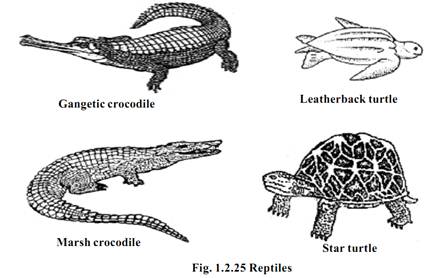
The body is variable in shape. It is covered with an exoskeleton of horny imbricate epidermal scales. Skin glands are practically absent. The limbs are of pentadactyl type adapted for climbing, running and paddling. The endoskeleton is well ossified. Respiration is by lungs. The heart is three chambered (In crocodiles it is four chambered). The functional kidney of the adult is metanephros. The Sexes are separate. Fertilization is internal. The eggs are covered with leathery shells. Reptiles have developed some form of copulatory organ to transfer the sperms into the cloaca of the female.
Example: Garden lizard, Cobra, Monitor lizard, Crocodile, Turtle.
Class: Aves
Birds are one of the most interesting and widely known group of animals. There are more than 8600 species of birds distributed all over the world. Birds as a group exhibit a characteristic uniformity in structure.
Aves are warm blooded vertebrates with an exoskeleton of feathers forming a non-conducting covering to keep the body warm. The feet are covered with scales. The forelimbs are modified as wings and provided with feathers for flight. The hindlimbs are attached far forwards to balance the weight of the body. The bones are spongy, containing air-cavities rendering the body light. There is a fusion of bones and this is especially seen in the vertebral column. Only three digits are present in the forelimbs. In the hindlimbs there are four toes with the first directed backwards. A horny beak is present.
The alimentary canal ends in a cloaca. Inside the body air sacs are present and some of them communicate with air cavities in the bones. The heart is four chambered. The red blood corpuscles are oval and nucleated. The kidneys are three lobed. The ureters open into the cloaca. Urine is semisolid and contains uric acid. The nervous system is well developed. Eyes are usually powerful and a specialized structure called pecten is present inside the eye ball to help in accomodation. Sexes are separate, Fertilization is internal. Eggs are provided with large amount of yolk. The egg is covered by a hard calcareous shell. In spite of several advanced features the birds have certain reptilian characters. Hence they are known as “glorified reptiles”.
Examples: Pigeon, parrot, crow, sparrow, peakcock, ostrich, penguin.
Class: Mammalia
The term “mammalia” was given by Linnaeus (1758) to that group of animals which are nourished by milk from the breasts of the mother. They are a successful group, for they adapt themselves readily to new situations and to new food habits.
The body is generally covered with epidermal hairs. The integument is provided with sweat, sebaceous and scent glands. The mammary glands are modified integumentary glands. The external ear or the pinna is present in most of the mammals. A muscular diaphragm is present in between thoracic and abdominal cavities. It helps in respiration. The red blood corpuscles are non-nucleated, biconcave and usually circular in form. The heart is four chambered. Only the left aortic arch is present. In brain cerebral hemispheres are very large and highly convoluted.
Corpus callosum, a transverse band of nerve fibres connecting the two cerebral hemispheres, is present. Dentition is thecodont, heterodont and diphyodont. Cloaca is absent. Testes lie outside the body cavity, enclosed in scrotal sacs. Eggs are small with little or no yolk. Fertilization is always internal. Mammals are Viviparous i.e., they give birth to alive young ones. Placenta is usually present.
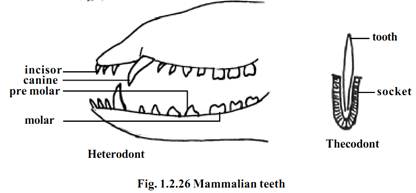
The class Mammalia is subdivided into three subclasses namely Monotremata, Marsupialia and Placentalia.
1-Sub class: Monotremata or Prototheria

These are primitive egg laying mammals Example : Spiny ant-eater, duck billed platypus.
2-Sub class: Marsupialia or Metatheria
These are popularly called as marsupials or pouched mammals. The young ones are born in an immature stage and migrate into the pouch on the mother’s body. Further development is completed in the pouch or marsupium.
Example: Kangaroo
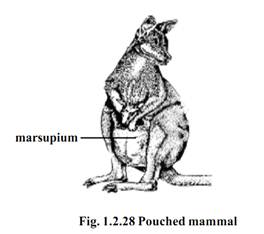
3- Sub class: Placentalia or Eutheria
In this group eggs develop within the uterus. The developing embryo receives nutrition through maternal blood circulation via the placenta.
Example: Elephant, tiger, lion, man, monkey, dog, cat , rat, bat
Order Primates:
It is an order coming under the subclass Eutheria. This order is of interest because it includes man, besides lemurs, tarsiers, monkeys and apes. They inhabit chiefly the warmer parts of the world. This group stands first in the animal kingdom in brain development. However, most of them are unspecialized and tree dwelling (arboreal). Primates are omnivorous in habit. The body is covered with hairs except palm, sole and parts of face. The neck is mobile. The forelimbs are shorter than the hindlimb. The limbs have five digits and all the digits end in flat nail. The pollex or thumb or first toe are smaller than other digits and are opposable (except the hallux of man). The brain is highly developed. The cerebral hemispheres are much convoluted and cover the cerebellum. The eyes are directed forward and the vision is binocular and stereoscopic. Mammae are two and thoracic in position.
References
T. Sargunam Stephen, Biology (Zoology). First Edition – 2005, © Government of Tamilnadu.



|
|
|
|
دراسة تحدد أفضل 4 وجبات صحية.. وأخطرها
|
|
|
|
|
|
|
جامعة الكفيل تحتفي بذكرى ولادة الإمام محمد الجواد (عليه السلام)
|
|
|